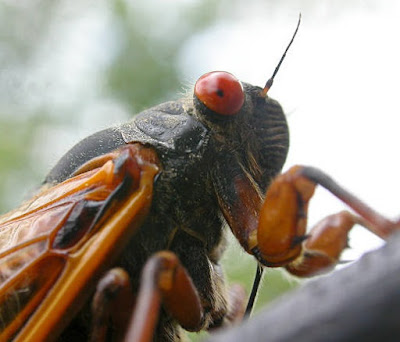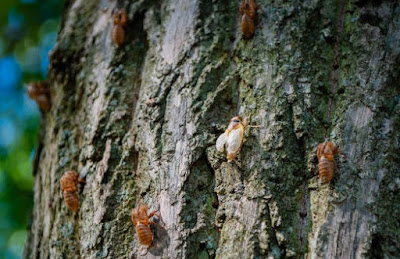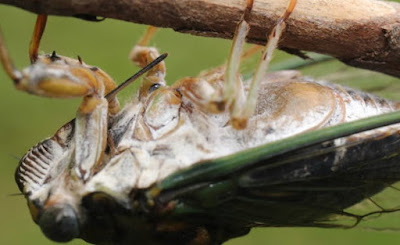There are more than 3,000 different species of cicadas around the world.
Cicadas can be found on every continent except Antarctica. There are
almost 200 species in the United States, roughly a dozen in Canada, and 100s
of them in Australia.
Cicadas fall into two categories... annual and periodical.
Annual cicadas emerge from the ground regularly each year. Periodical
cicadas can emerge every 2, 5, 13, or 17 years depending on what species
they are.
Cicadas are not locusts.
Even though cicadas and locusts are noise-making insects and can be seen in
hordes, they are two completely different species. Locusts are closely
related to grasshoppers and crickets, whereas cicadas are closely related to
aphids and planthoppers.
This is a yellow-winged locust... not a cicada.
A group of cicadas is called a chorus.
Male cicadas will sing together to establish their territory and to attract
female cicadas. Different species of cicadas will sing at different
times during the day and the weather will affect how loudly or quietly they
sing. Some scientists believe cicadas also sing loudly as a way to
keep predators away.
Male cicadas have a tymbal organ in their abdomens.
When male cicadas sing, they contract the tymbal muscles to make a clicking
sound. The faster they contract and relax these muscles, the louder
their clicks get. It takes 120 to 480 clicks PER SECOND to make the
noise... err... singing people can hear.
Cicadas have a long lifespan.
Cicadas spend the majority of their lives underground and we usually don't
see them until they emerge at the end of their life cycle. Depending
on what species they are, cicadas will spend two to 17 years underground
tunneling, eating, sleeping, etc. Contrary to popular belief...
cicadas are not hibernating underground... they are very much alive and
active!
Cicadas have a life cycle similar to ants, wasps, and fleas.
Cicadas don't form a chrysalis or pupa during their life cycle. When
they hatch from their eggs as nymphs, they look like tiny
little insects with legs, a distinct abdomen, and antennae. As they
grow and develop, they will molt several times before becoming
adults.
The shrill thorntree cicada is the loudest cicada in the world.
Their songs can be as loud as 106 decibels. That is as loud as a
lawnmower, a farm tractor, a motorcycle, or a jackhammer!
Cicadas are edible.
For many people around the world, cicadas are a delicacy. Cicadas are
low carb, high protein, and gluten-free. They can be fried, grilled,
sprinkled on pizza and salads, and even dipped in chocolate. Have you
or would you ever eat a cicada?
Did you enjoy learning fun facts about cicadas? If so, check out
these blog posts with fun facts about more animals:
- Factoids: Fun Facts About Mountain Lions and P22
- Factoids: Fun Facts About Sled Dogs
- Factoids: Fun Facts About Camels
- Factoids: Fun Facts About Groundhogs
- Factoids: Fun Facts About Reindeer
- Factoids: Fun Facts About Rhinoceroses
- Factoids: Fun Facts About Honey Bees
- Factoids: Fun Facts About Sloths












No comments:
Post a Comment
Note: Only a member of this blog may post a comment.